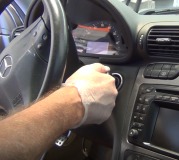The first thing to look at is whether you get a nice "idle flare-up" to at least 1500 rpm when it starts. If it does, and then comes right back down to around 800 rpm, the idle control system is working. From your original description, I suspect this is not the case.
The next thing is to connect a scanner that can display live data. Watch the "AIS Steps". The Engine Computer can command the automatic idle speed motor to any of 256 positions called steps. For a properly running engine, step 32 is about normal. If you find it at step 0 before starting the engine, the computer has not learned minimum throttle. You must coast for a minimum of seven seconds for that to take place. Five seconds won't do it.
If your truck has cruise control, the brake switch will have up to three sections. Even though the brake lights are not stuck on, a pitted contact can block the relearn from taking place. My Chrysler DRB3 scanner shows the status of the brake light switch so it's real easy to see if it's working properly. On some vehicles the part of the brake switch that kicks the cruise control off can block the minimum throttle relearn from taking place. You might get a clue if the cruise control won't set too.
If you find the AIS is at around step 50, it has been set to the starting point and should provide the idle flare-up. If you still have to press the gas pedal to get the engine started, one of two things is blocking the air flow through the passage around the throttle blade. That passage is blocked with carbon or the motor is not responding. Carbon buildup used to be real common on the 3.0L in the early '90s, but with better additives in fuel today, I haven't had to clean one in a long time. Other engines didn't seem to have that much trouble.
The Engine Computer constantly monitors the AIS motor and its wiring. It will set a diagnostic fault code in memory and turn on the Check Engine light if it sees a problem. Besides that, the armature can become tight and fail to turn. The motor is not a regular motor that spins rapidly. It is a metal core that is placed in various positions by pulsing current through four electromagnetic coils. As it turns to those positions, a screw thread extends or retracts a pintle valve to expose more or less of the air passage. At the same time as it opens that valve to let more air in, it also lengthens the on-time of the injectors' pulses. More air and fuel increases the idle speed.
Many scanners have a test mode for testing the AIS motor operation. By pressing the right sequence of buttons, you can tell the Engine Computer to bump the idle speed up to 2000 rpm in 200 rpm increments. If that fails to occur, suspect the AIS motor itself.
Another thing you can do without a scanner is to remove the AIS motor from the throttle body, then watch what it does when a helper turns the ignition switch to "run". You should see the valve retract. If it does not move, squeeze the valve to force it in. It's going to take both hands and lots of force, but it will move. The total length of its travel is about 1/4". If you leave the ignition switch on while you reinstall the motor, then turn it to "crank" without turning it off first, the engine should start and have a really high idle speed. If the idle speed doesn't come down within about five seconds, suspect the motor is defective. There are four coils of wire inside that are all connected together. If only one has a broken connection, electrically the entire motor will still appear to be okay to the computer, but it won't respond properly to the computer's commands. You can't test the AIS motor with an ohm meter because all four coils are interconnected. If one coil is open, the meter will just read through the other three. Also be aware the AIS motor is held on with two Torx bolts with thread lock on the threads. Your Torx bit must be the proper size and it must be fully seated to prevent rounding the heads off. New motors come with new bolts with that thread lock already on them.
If you turn the ignition switch off, then back on to start the engine, the computer will run the AIS motor more than enough to completely close the valve, then it will back it off to around step 50 in preparation for starting. That's why if you retract the valve by hand, then reinstall the motor, you must not turn the ignition switch off before cranking the engine.
It's always possible one of the drivers in the computer has failed so it won't adjust the AIS motor. That is extremely rare. I've never solved a low idle complaint by replacing the computer. About one out of twenty complaints were solved by replacing the AIS motor. The rest just needed a test drive and nice long coast.
Monday, January 2nd, 2012 AT 9:57 PM




